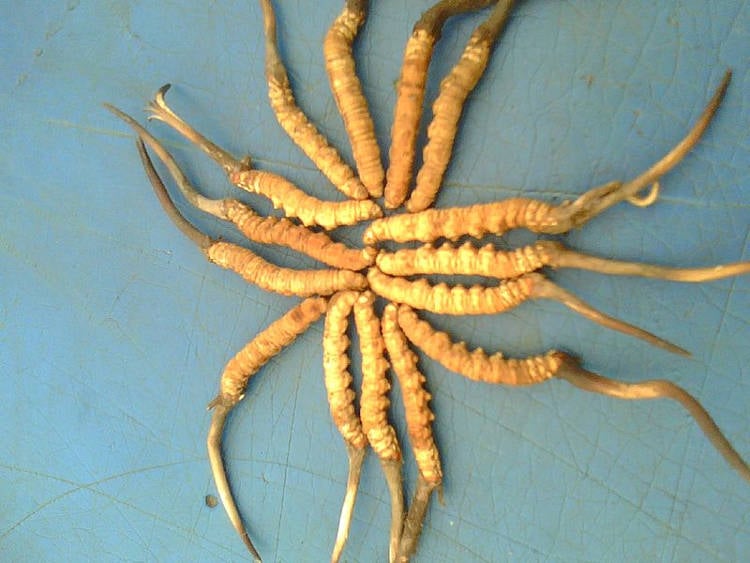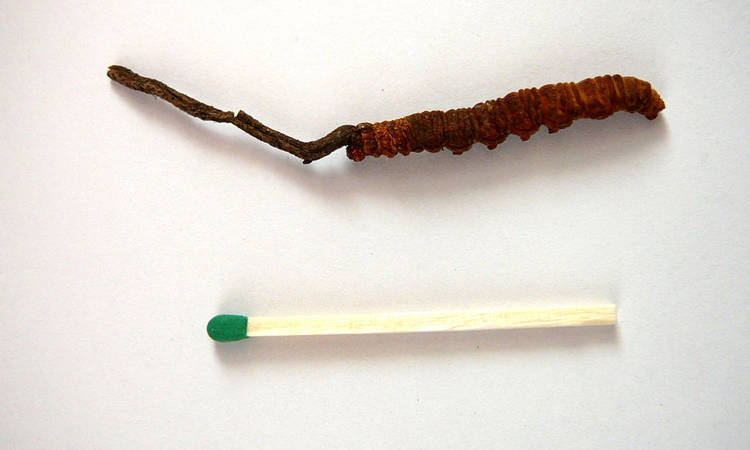Yartsa Gunbu, a fungus that infects ghost moth caterpillars on the Tibetan Plateau, is considered by far the most expensive parasite in the world, fetching up to $50,000 a pound.
A close relative of the tropical parasite that infects ants and turns them into zombies, Ophiocordyceps sinensis is only found on the Tibetan Plateau, where it infects the larvae of ghost moths while they are buried deep underground and feeding on plant roots. The larvae are most vulnerable in the summer, when they shed their skins, becoming more easily infected. The parasite slowly grows in its hose by consuming it during the fall and winter, and just when the snow starts to melt, it pushes its dying larvae host upward and grows a plant-like, spore-filled stalk that pierces the ground, becoming the way to spot the valuable Yartsa Gunbu. It is then harvested by local villagers and sold modest prices that turn into a fortune as the fungus passes through several middleman, costing the final client more that three times its weight in gold.

Photo: Deepak Raj Bhatt/Wikimedia Commons
The name Yartsa Gunbu actually means “summer grass, winter worm”, a simple and effective description of the fungus’ life cycle. The most valuable specimens contain both the spore-filled stalk that shoots upward from the host’s head, as well as the body of the dead ghost moth, but harvesting it hole is a very difficult process. Not only is the stalk difficult to spot, as it closely resembles the sedges growing on the Tibetan Plateau, but the hard ground makes unearthing a Yartsa Gunbu without breaking the stalk very challenging.
As you can imagine, sources of income are pretty scarce high up in the arid Tibetan Plateau, so Yartsa Gunbu is a good way for local communities to supplement their yearly earnings. In Buthan, for example, the fungus trade makes up a considerable part of the gross domestic products, and in many Tibetan villages, harvesting the fungus is one of the few ways for families to sustain themselves. While they usually sell Yartsa Gunbu for only a few hundreds of dollars per pound, the earnings make up a substantial part of the yearly budget.

Photo: Nikolas Merky/Wikimedia Commons
After passing through chains of middlemen, the Yartsa Gunbu parasites reach Hong Kong and bustling metropolises in mainland China, where they sell for ludicrous amounts of money. The parasites have long been popular among the ultra-rich Chinese, mainly for its alleged medicinal properties (according to Chinese medicine), but before the early 90’s only a few could afford to actually import the valuable commodity. Things changed once China’s bustling economy created a whole new generation of elites.
Yartsa Gunbu owes its success to Chinese medicine and several stories that boosted its reputation as a cure-all, powerful aphrodisiac, and physical function enhancer. In 1993, when a number of Chinese athletes unexpectedly broke several world records in track-and-field events, their coach famously credited Yartsa Gunbu consumption for their feats, and a decade later, rumors started going around that the fungus could protect people from SARS infection. While none of these touted benefits were ever scientifically proven, Yartsa Gunbu trade exploded, and so did its price.

Yartsa Gunbu shop, Tibet (Photo: Erik Torner/Flickr)
According to The Atlantic, the global market for Yartsa Gunbu was worth between $5 and $11 billion, with the finest specimens of the parasite selling for up to $140,000 per kilogram. But even cheaper specimens are highly coveted in China, where even members of the middle-class have started spending small fortunes on it, taking it as a prophylactic against all sorts of conditions.
Unfortunately, the dependence of Tibetan Plateau communities on Yartsa Gunbu and the seemingly ever-growing demand for the fungus is not without consequences for the environment. Experts have long cautioned that over-harvesting could lead to the disappearance of the fungus, but sadly that is not the only cause for the noticeable scarcity of the fungus in recent years. Global warming is believed to play a huge role as well, and the fragile ecosystem is having trouble keeping up with the rate at which mountain ranges around the world are getting warmer.
With Yartsa Gunbu becoming noticeably scarcer, and the demand from China steadily going up, it’s likely that the end price for this unusual commodity will likely go up even more, which is just crazy to comprehend for most people…






